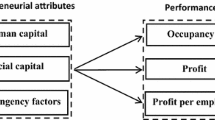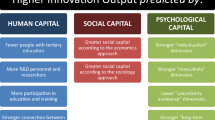Abstract
This paper explores, based on the varieties-of-capitalism approach, configurations of key human resource management practices that explain radical innovation in subsidiaries. A fuzzy-set qualitative comparative analysis is conducted with data for 69 subsidiaries of US-based MNEs in Germany, Switzerland, and the UK. Contrary to the implications of the varieties-of-capitalism literature, combining numerical flexibility and employing a high share of academics does not necessarily achieve radical innovation. Various paths to radical innovation exist, and most of them involve functional flexibility. Overall, the findings emphasize the strategic discretion MNEs have, and accentuate that functional flexibility is a key HR practice to achieve radical innovation across differing varieties of capitalism countries.

Similar content being viewed by others
References
Akkermans D, Castaldi C, Los B (2009) Do “liberal market economies” really innovate more radically than “coordinated market economies”? Hall and Soskice reconsidered. Res Policy 38(1):181–191
Allen M (2004) The varieties of capitalism paradigm. Not enough variety? Socio-Econ Rev 2(1):87–108
Allen MMC (2013) Comparative capitalisms and the institutional embeddedness of innovative capabilities. Socio-Econ Rev 11(4):771–794
Allen MMC, Aldred ML (2011) Varieties of capitalism, governance, and high-tech export performance: a fuzzy-set analysis of the new EU member states. Empl Relat 33(4):334–355
Arundel A, Lorenz E, Lundvall B-A, Valeyre A (2007) How Europe’s economies learn. A comparison of work organization and innovation mode for the EU-15. Ind Corp Change 16(6):1175–1210
Arvanitis S (2005) Modes of labor flexibility at firm level: are there any implications for performance and innovation? Evidence for the Swiss economy. Ind Corp Change 14(6):993–1016
Atkinson J (1984) Manpower strategies for flexible organizations. Pers Manag 16(8):28–31
Bamber G, Lansbury RD, Wailes N (eds) (2011) International and comparative employment relations. Globalisation and change. Sage, Los Angeles
Bassanini A, Ernst E (2002) Labour market regulation, industrial relations and technological regimes. A tale of comparative advantage. Ind Corp Change 11(3):391–426
Bouncken RB, Lehmann C, Ratzmann M (2013) Shades of gray: effect of external work arrangements on firm performance under operational and strategic contingencies. J Bus Econ 83(8):863–900
Brewster C, Wood G, Brookes M (2006) Varieties of capitalism and varieties of firm. In: Wood G, James P (eds) Institutions, production, and working life. Oxford University Press, Oxford, pp 217–234
Bureau van Dijk (ed) (2009) Amadeus. Bureau van Dijk, Amsterdam
Cappelli P, Neumark D (2004) External churning and internal flexibility: evidence on the functional flexibility and core-periphery hypotheses. Ind Relat 43(1):148–182
Casper S (2007) Creating silicon valley in Europe. Public policy towards new technology industries. Oxford University Press, Oxford
Ciabuschi F, Forsgren M, Guy F (2011) Rationality vs ignorance: the role of MNE headquarters in subsidiaries’ innovation processes. J Int Bus Stud 42(7):958–970
Crilly D (2010) Predicting stakeholder orientation in the multinational enterprise: a mid-range theory. J Int Bus Stud 42(5):694–717
Crouch C (2005) Models of capitalism. New Polit Econ 10(4):339–456
Doty DH, Glick WH, Huber GP (1993) Fit, equifinality, and organizational effectiveness: a test of two configurational theories. Acad Manag J 36(6):1196–1250
Estevez-Abe M, Iversen T, Soskice D (2001) Social protection and the formation of skills: a reinterpretation of the welfare state. In: Varieties of capitalism: the institutional foundations of comparative advantage. University Press, Oxford, pp 145–183
Farndale E, Brewster C, Poutsma E (2008) Coordinated vs. liberal market HRM: the impact of institutionalization on multinational firms. Int J Hum Resour Manag 19(11):2004–2023
Fenton-O’Creevy M, Gooderham P, Nordhaug O (2007) Human resource management in US subsidiaries in Europe and Australia: centralisation or autonomy? J Int Bus Stud 39(1):151–166
Fiss PC (2007) A set-theoretic approach to organizational configurations. Acad Manag Rev 32(4):1190–1198
Fiss PC (2011) Building better causal theories: a fuzzy set approach to typologies in organization research. Acad Manag J 54(2):393–420
Flickinger M, Gruber-Mücke T, Fiedler M (2013) The linkage between human resource practices and organizational ambidexterity: an analysis of internal labor market dynamics in a port-of-entry context. J Bus Econ 83(8):923–946
García-Castro R, Aguilera RV, Ariño MA (2013) Bundles of firm corporate governance practices: a fuzzy set analysis. Corp Gov Int Rev 21(4):390–407
Geletkanycz MA (1997) The salience of ‘culture’s consequences’: the effects of cultural values on top executive commitment to the status quo. Strateg Manag J 18(8):615–634
Giannetti C, Madia M (2013) Work arrangements and firm innovation: is there any relationship? Camb J Econ 37(2):273–297
Greckhamer T, Misangyi VF, Elms H, Lacey R (2008) Using qualitative comparative analysis in strategic management research. An examination of combinations of industry, corporate, and business-unit effects. Organ Res Methods 11(4):695–726
Gresov C, Drazin R (1997) Equifinality: functional equivalence in organization design. Acad Manag Rev 22(2):403–428
Hall PA, Soskice D (2001) An Introduction to Varieties of Capitalism. In: Hall PA, Soskice D (eds) Varieties of capitalism. The institutional foundations of comparative advantage. Oxford University Press, Oxford, pp 1–68
Heidenreich M (2012) The social embeddedness of multinational companies: a literature review. Socio-Econ Rev 10(3):549–579
Henisz WJ (2000) The institutional environment for multinational investment. J Law Econ Organ 16(2):334–364
Henisz W, Swaminathan A (2008) Institutions and international business. J Int Bus Stud 39(4):537–539
Herrmann AM, Peine A (2011) When ‘national innovation system’ meet ‘varieties of capitalism’ arguments on labour qualifications: on the skill types and scientific knowledge needed for radical and incremental product innovations. Res Policy 40(5):687–701
Iseke A, Schneider M (2012) Transfer of employment practices, varieties of capitalism, and national employment systems, a review. Ind Bezieh Z Arbeit Organ Manag 19(2):236–252
Jackson G (2005) Employee representation in the board compared. A fuzzy sets analysis of corporate governance, unionism and political institutions. Ind Bezieh 12(3):252–279
Jackson G, Deeg R (2008) Comparing capitalisms: understanding institutional diversity and its implications for international business. J Int Bus Stud 39(4):540–561
Jackson G, Miyajima H (2007) Varieties of capitalism, varieties of markets. Mergers and acquisitions in Japan, Germany, France, the UK and USA. doi:10.2139/ssrn.1012210. Available at SSRN: http://ssrn.com/abstract=1012210
Jensen MB, Johnson B, Lorenz E, Lundvall BA (2007) Forms of knowledge and modes of innovation. Res Policy 36(5):680–693
Kalleberg AL (2001) Organizing flexibility: the flexible firm in a new century. Br J Ind Relat 39(4):479–504
Kluike M, Pull K (2013) Similar, but still different: how US multinational companies in Germany and Switzerland use host-country training and skill practices. Ind Relat J 44(5–6):495–513
Kristensen PH, Morgan G (2012) Theoretical contexts and conceptual frames for the study of twenty-first century capitalisms. In: Morgan G, Whitley R (eds) Capitalisms and capitalism in the twenty-first century. OUP, Oxford, pp 11–45
Lange K (2009) Institutional embeddedness and the strategic leeway of actors: the case of the German therapeutical biotech industry. Socio-Econ Rev 7(2):181–207
Latzer M (2009) Information and communication technology innovations: radical and disruptive? New Media Soc 11(4):599–619
Lazonick W (2010) The Chandlerian corporation and the theory of innovative enterprise. Ind Corp Change 19(2):317–349
Lorenz E (2011) Do labour markets and educational and training systems matter for innovation outcomes? A multi-level analysis for the EU-27. Sci Public Policy 38(9):691–702
Lorenz E, Valeyre A (2005) Organisational innovation, human resource management and labour market structure: a comparison of the EU-15. J Ind Relat 47(4):424–442
Marsden D (2000) A theory of job regulation, the employment relationship, and the organisation of labour institutions. Ind Bezieh 7(4):320–347
Marx A (2010) Crisp-set qualitative comparative analysis (csQCA) and model specification: benchmarks for future csQCA applications. Int J Multiple Res Approaches 4(2):138–158
Meuer J, Rupietta C, Backes-Gellner U (2015) Layers of co-existing innovation systems. Res Policy 44(4):888–910
Meyer AD, Tsui AS, Hinings CR (1993) Configurational approaches to organizational analysis. Acad Manag J 36(6):1175–1195
Minbaeva D, Pedersen T, Björkman I, Fey CF, Park HJ (2003) MNC knowledge transfer, subsidiary absorptive capacity, and HRM. J Int Bus Stud 34(6):586–599
Pajunen K (2008) Institutions and inflows of foreign direct investment. A fuzzy-set analysis. J Int Bus Stud 39(4):652–669
Parry E, Dickmann M, Morley M (2008) North American MNCs and their HR policies in liberal and coordinated market economies. Int J Hum Resour Manag 19(11):2024–2040
Peck J, Theodore N (2007) Variegated capitalism. Prog Hum Geogr 31(6):731–772
Porter ME (1990) The competitive advantage of nations. The Free Press, New York
Pudelko M, Harzing A (2007) Country-of-origin, localization, or dominance effect? An empirical investigation of HRM practices in foreign subsidiaries. Hum Resour Manag 46(4):535–559
Pull K (2003) Managerial flexibility and the comparative attractiveness of the UK as a business location. Eur Bus J 15(2):49–60
Pull K (2008) Flexibility in HRM and foreign direct investment: do international investors self-select? Int J Hum Resour Manag 19(2):314–329
Ragin CC (1987) The comparative method. Moving beyond qualitative and quantitative strategies. University of California Press, Berkeley
Ragin CC (2000) Fuzzy-set social sciences. University of Chicago Press, Chicago
Ragin CC (2006) Set relations in social research. Evaluating their consistency and coverage. Polit Anal 14(3):291–310
Ragin CC (2008) Redesigning social inquiry. Fuzzy sets and beyond. University of Chicago Press, Chicago
Ragin C, Davey S (2009) fs/QCA, Version 2.5. University of Arizony, Tucson
Ragin CC, Fiss PC (2008) Net effects analysis versus configurational analysis: an empirical demonstration. In: Ragin CC (ed) Redesigning social inquiry: Fuzzy sets and beyond. University of Chicago Press, Chicago, pp 190–212
Ragin CC, Strand SI (2008) Using qualitative comparative analysis to study causal order. Comment on Caren and Panofsky (2005). Sociol Methods Res 36(4):431–441
Rihoux B, Ragin C (2009) Configurational comparative methods. Qualitative comparative analysis (QCA) and related techniques. Sage, Thousand Oaks
Schmitt M, Sadowski D (2003) A cost-minimization approach to the international transfer of HRM/IR practices. Anglo-Saxon multinationals in the Federal Republic of Germany. Int J Hum Resour Manag 14(3):409–430
Schneider MR, Paunescu M (2012) Changing varieties of capitalism and revealed comparative advantages from 1990 to 2005: a test of the Hall and Soskice claims. Socio-Econ Rev 10(4):731–753
Schneider CQ, Wagemann C (2012) Set-theoretic methods for the social sciences: a guide to qualitative comparative analysis. Cambridge University Press, Cambridge
Schneider MR, Schulze-Bentrop C, Paunescu M (2010) ‘Mapping the institutional capital of high-tech firms. A fuzzy-set analysis of capitalist variety and export performance. J Int Bus Stud 41:246–266
Schulze-Bentrop C (2013) Qualitative comparative analysis (QCA) and configurational thinking in management studies. PL Academic Research, Frankfurt
Taylor MZ (2004) Empirical evidence against varieties of capitalism’s theory of technological innovation. Int Organ 58(Summer):601–631
Teuber S (2012) The effect of vocational education and labor market institutions on personnel and organizational strategies—an international comparison. e-Diss, Zürich
Valverde M, Tregaskis O, Brewster C (2000) Labor flexibility and firm performance. Int Adv Econ Res 6(4):649–661
Wilkens U, Ruiner C, Küpper M (2013) Flexible arrangements with the highly qualified workforce: antecedents and effects of different contract policies in knowledge-intensive firms. J Bus Econ 83(8):837–861
Witcher BJ, Chau VS (2012) Varieties of capitalism and strategic management: managing performance in multinationals after the global financial crisis. Br J Manag 23:S58
Witt MA, Lewin AY (2007) Outword foreign direct investment as escape response to home country institutional constraints. J Int Bus Stud 38(4):579–594
Zhou H, Dekker R, Kleinknecht A (2011) Flexible labor and innovation performance: evidence from longitudinal firm-level data. Ind Corp Change 20(3):941–968
Acknowledgments
This study was funded by research grants from the German National Science Foundation and the Swiss National Science Foundation; Silvia Teuber also received a mobility grant of the Swiss National Science Foundation for a research stay at Harvard University and was partly funded by the Swiss Leading House on Economics of Education, Firm Behavior and Training Policies.
Author information
Authors and Affiliations
Corresponding author
Rights and permissions
About this article
Cite this article
Backes-Gellner, U., Kluike, M., Pull, K. et al. Human resource management and radical innovation: a fuzzy-set QCA of US multinationals in Germany, Switzerland, and the UK. J Bus Econ 86, 751–772 (2016). https://doi.org/10.1007/s11573-015-0803-3
Published:
Issue Date:
DOI: https://doi.org/10.1007/s11573-015-0803-3
Keywords
- Functional flexibility
- Numerical flexibility
- Radical innovation
- Radical change
- Varieties of capitalism
- Qualitative comparative analysis




